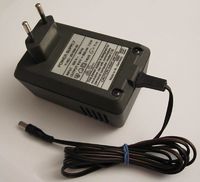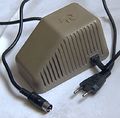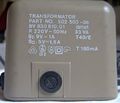Power Supply
A power supply is used to convert power from the wall socket to the appropriate voltage, current and form of electricity for the intended application, such as powering a computer.
General[edit | edit source]
A Power Supply Unit (PSU) is always necessary when the voltage from the electricity grid is too high or too low for the intended application. The most common application is reducing the voltage.
There are mainly two types of PSUs: linear power supplies and switched power supplies.
Linear power supplies always deliver a DC voltage and have a simple structure. They contain a transformer whose primary coil is fed by the mains. The transformer transforms the AC voltage to are more suitable AC voltage and also supplies a galvanic isolation. A diode bridge rectifier then converts this AC voltage into a pulsing DC voltage. Finally, smoothing capacitors and a linear voltage regulator produces a constant DC output voltage.
A switched power supply does not operate at the 50 or 60 Hz frequency of the mains, but uses electronic circuitry to work with a much higher frequency. In this way, much smaller transformers can be used and the efficiency factor raises noticeably. The structure is much more complex than a linear power supply, because the pulse-width ratio has to vary according to the load.
Types[edit | edit source]

Power Supply[edit | edit source]
Wall-warts are the most common PSUs used for low power applications. On this type the mains plug is integrated in the case of the Power supply. The output Voltage is usually delivered by a fixed cable with a fixed connector. These power supplies are usually meant for one specific type of device and rarely can be used with other device types. There are also so called universal power supplies. These normally have an adapter connection, where different types of connectors can be attached, so they will fit to different devices. Additionally the output voltage can be adjusted.
Due to the compact design, they are easy to transport. However they are limited in their power output and will be used for small devices or devices with low power consumption only.
Wall-warts are most commonly used with mobile phones, cordless phones, charging devices and similar.
External Power Supplies[edit | edit source]
External power supplies are power supplies that are housed in their own case outside the unit. They contain a unit with one cable to connect directly to the appliance with either another cable or a connector to connect it to a wall. For some, it is also possible to remove the power cord, as it is connected with a standard plug.
Usually, larger units will yield higher output power, however, there is a considerable amount of heat generation, so good ventilation is a must.
This is the most common type used by Commodore. It is used with the C64/128/16/116, Plus/4, VIC-20 and the 1541-II and 1581 disk drives.
Internal Power Supply[edit | edit source]
For internal power supplies usually assemblies are used which are mounted inside of the cabinet of the device. We can distinguish between the open and the closed assembly. With the open assembly the power supply is integrated on the main printed circuit board without protection. This is used with devices, which are usually not opened by the user. The closed or encapsulated power supplies have an own cabinet and will be build with this into the device.
Through the possibility to place the power supply unit within the cabinet of the device, its power can be significantly increased. However this has the disadvantage, that the cabinet has to be noticeably larger. The additional space is not only for the power supply but also for the ventilation. The biggest advantage with this construction is, that quite a lot of power is available with little limitations.
Open internal power supplies are used in a lot of devices, especially in bigger devices and if high power is needed, i.e. a CRT TV.
Closed internal power supplies are mostly used in modern PCs. The advantage is, that these power supplies can be considered as a component and can be exchanged with little effort. Because of the closed design, they are safe during operation and the device can be opened in which the PSU is build in.
Commodore used internal power supplies in their monitors and printers (except the MPS-1270). Also in the C128D, 1571 and the CBM series.
Power Supplies of the Commodore 64[edit | edit source]
The Commodore 64 is supplied by an external power supply unit via the power supply connector. It needs 5V DC voltage and 9V AC voltage. The 5V DC voltage should fluctuate in a range of 4.95 to 5.10 Volt, else the C64 will not work properly. The power supply normally produces a voltage slightly higher than 5V, because of a small resistor between the voltage regulator and ground in the power supply.
C64 power supplies were made by at least three manufacturers. European Commodore 64s were typically accompanied with a power supply manufactured by a company called Ismet Transformatoren. Ismet still exists today and manufactures high end transformers. C64s manufactured in the far east (especially C64C) were usually accompanied with power supplies by Dee Van, a Taiwanese manufacturer that also still exists today, and still manufactures power supplies for consumer electronics. The manufacturer(s) of the power supplies American C64s is not known to this Wiki.
-
C64 power supply by Ismet
-
Rear view of the Ismet PSU
-
A later C64 power supply by Ismet
-
C64 power supply by Dee Van
Failure[edit | edit source]
Owners of a C64 using an original power supply should regularly (for example, once a year) check the 5V DC function of their power supplies, as they tend to produce higher voltages as they wear out. Because the C64 almost directly uses the 5V to power its chips, higher voltages can become dangerous for the Commodore 64. If you measure the voltage of your power supply, you should interpret this as follows:
| 4.95 - 5.1V | Power supply functions normally |
| 5.1 - 5.2V | Minor concern, measure the power supply more often |
| 5.2 - 5.5V | The power supply is failing. Your Commodore 64 will not die right away, but it is an unhealthy situation. Replacement or repair of the power supply is recommended. |
| 5.5 - 6V | Your Commodore 64 is in danger. |
| >6V | In most situations where a Commodore 64 got killed by its power supply, the voltage had risen above 6V. Usually the RAM memory gets damaged first. |
The 9V AC line seldom breaks in the original power supplies and the power circuits of the C64 handle slight voltage differences.
Repair[edit | edit source]
Some power supplies can be repaired and serviced easily, but others cannot due to the cases being glued together and the components potted.
Designing a Home Built Power Supply[edit | edit source]
Should you want to design your own power supply, it needs to conform to these specifications:
- Galvanic separation between the 5V DC and 9V AC lines is recommended. For a power supply without galvanic separation between 5V DC and 9V AC, you must first study the power circuits of the C64 mainboard to avoid that undesired currents will flow between the 5V DC and 9V AC lines.
- 9V AC is usually generated by a transformer. Transformers drop their voltages if they are loaded: The transformer produces more than 9V when the C64 is off, and less when the C64 is on. This is no problem, the power circuits in the C64 handle this properly.
- However, the minimum possible AC voltage on which the C64 will work correctly is about 8.1V AC. Make sure the voltage stays within safe margin from this, and test this with a datasette (which draws additional power from the 9V)
- The AC voltage while the C64 is on should also not be much higher than 9V, as excess voltage is converted into heat, of which you don't want to produce too much. Therefore, do not use a too heavy (large VA or current rating) transformer.
- Respecting this, you will generally find that you need a transformer with a rating in the range of 9V @ 10-15 VA (9V @ 1.11A to 9V @ 1.66A), even though the C64 only draws approximately 5VA from the 9V line when in normal operation.
- VA is a power rating; another way to measure the output capacity of a transformer. The relationship to current capacity is: Current = Power / Voltage, hence above: 9V @ 10VA is a 10/9 = 1.11A transformer.
- The original C64 power supplies can deliver, depending on type, 1.5-1.7A @ 5V DC and 1.0-1.11A @ 9V AC.
- Most replacement PSUs either follow the original voltage and current specifications, or are uprated to around 2-5A @ 5V DC and 1.5-2A @ 9V AC. The higher capacity is better, especially because modern cartridges, such as the 1541 Ultimate, increase the power needs of the C64 setup. The additional power capacity also supports original add-ons such as the REU RAM Expansion Units, which required a power supply capable of delivering at least 2.5A @ 5V (plus the 9V AC supply).
- When buying a new/replacement C64 PSU, aim for a higher-capacity model from a supplier who gets good user feedback.
The above guidelines are based on the needs of C64 mainboards with NMOS chipsets. C64 mainboards with HMOS chipsets (usually C64C) draw less power, but since a power supply needs to be able to power both types of mainboards, these are the guidelines to aim for.
Similar Topics[edit | edit source]
Links[edit | edit source]
| Supply Wikipedia: Power Supply |



